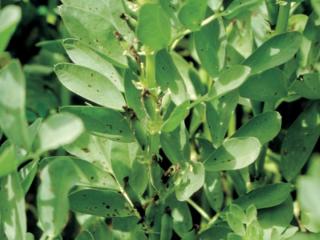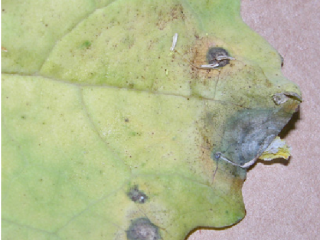Diseases caused by fungi and bacteria
Bacterial speck
Bacterial speck is a bacterial disease and results in small, black spots on leaves, stems and fruits of tomatoes, at all stages of growth. It is most common from winter to mid spring. Copper hydroxide may give some control.
Clubroot
Clubroot is a fungus disease that only affects Brassicas (the broccoli family). Plants are yellowish and stunted, with large malformed ‘clubbed’ roots. Clubroot may be severe in warm weather. Avoid growing brassicas in the same area for four years and lime the soil if it is acidic.
Leaf spot diseases
There are many types of leaf spot diseases that can affect beetroot, broad beans, carrots celery, peas, potatoes (early blight) silverbeet, and tomatoes (target spot). Sometimes the leaf spots cause only slight damage, but if necessary, control with mancozeb or copper hydroxide.
Damping-off
Damping-off fungal diseases such as pythium may kill small seedlings of most vegetables. Seedlings die before they emerge or soon after emergence, which results in plant collapse. Damage may occur all year, mainly in wet conditions. Do not over-water and ensure that plants are not too crowded.
Downy mildew
In spring, with mild, humid weather, downy mildew fungus disease can cause greyish-white patches on the leaves of onions, which can droop from the tips. Cauliflowers, peas and lettuce may show white, downy growth on the underside of the leaves. With rhubarb, patches develop which tear to produce holes in the leaves. The fungus that causes downy mildew in a particular crop is specific to that crop. Control with mancozeb or copper hydroxide.
Powdery mildew
Powdery mildew is a fungal disease. In warm, moist conditions, white patches occur on the surfaces of older leaves and leaves turn brown and shrivel. The disease is common with the cucurbit family such as cucumbers, melons, pumpkins and zucchini. It may also occur in peas and strawberries. Sulphur sprays will help to control the disease, but do not spray on hot days. Fungicides containing bicarbonate of soda also help control mildew but should be applied as soon as the disease is noticed.
Tuber diseases
Potato tubers may be infected with superficial skin diseases, such as common scab, powdery scab and rhizoctonia. Sweet potatoes may be infected by scurf. The tubers are often edible if the infected areas are cut out. Rotate crops and plant from healthy stock.
White mould
White mould or sclerotinia is a fungal disease that can attack most vegetables, especially beans, celery, lettuce and the broccoli family, mainly from spring to autumn. Soft brownish water rots develop mainly on the stems, followed by a fluffy white growth and small black pebble-like bodies. White mould may stay in the soil for many years and affect following crops. Do not over-crowd or over-water plants.
Wilt diseases
Fungal diseases such as fusarium, rhizoctonia and verticillium can cause wilting and death of most vegetables, by attacking roots and basal stems. Burn diseased plant remains, rotate crops and use new stakes. Some hybrid tomato varieties have resistance to fusarium.
Viruses and mycoplasmas
There are many types of viruses and mycoplasmas that can damage most vegetables. Symptoms are usually stunting, and mottled twisted leaves. There are no pesticides that can be used to kill viruses. These are often spread by aphids, thrips or leafhoppers. Reduce viruses by controlling these insects with pesticides.
Severe viruses include cucumber mosaic virus (most vegetables), zucchini yellow mosaic virus (cucumber, pumpkins, melons and zucchini), leaf roll virus and virus X and Y (potatoes), and spotted wilt virus (capsicums, lettuce and tomatoes). Big vein mycoplasma is common on lettuce in winter and does not have an insect vector. Big bud mycoplasma attacks tomatoes
Blossom end rot
Blossom end rot is not a disease. It occurs mainly in tomatoes, capsicums and watermelons as a dry rot at the end of the fruit. It is caused mainly by a shortage of water in hot weather and some varieties are more tolerant than others. Round varieties of watermelons are less affected by this rot.



